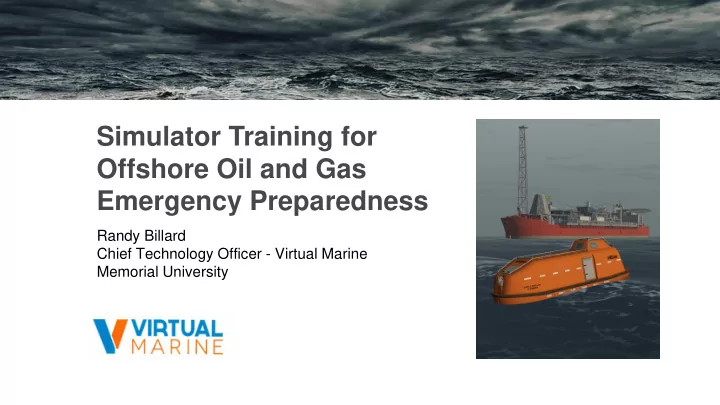

Simulator Training for Offshore Oil and Gas Emergency Preparedness Randy Billard Chief Technology Officer - Virtual Marine Memorial University
Overview o Experimental studies performed on lifeboat training o Simulator used to measure performance and provide exposure to harsh environments o Context for simulator users o Future studies
Study Goals o Investigate skills retention as lifeboat coxswains progress through a year long training program o Assess how learned skills transfer to a plausible emergency
Motivation o Industry adopting simulation in lifeboat training programs o Adopters sponsored study to validate simulator effectiveness o Series of experiments completed from 2015-2018 o Transfer, retention, specificity of training Recognitions of Equivalence
Retention and Transfer Experiment Lifeboat Launching o Representative of industry practice o Initial training at an onshore facility o Offshore quarterly drills consisting of launch of lifeboat in calm weather conditions o Same exercise performed each quarter o Hazards and fault conditions are not introduced
Experiment Overview Initial training • Emulated onshore training Initial Quarterly Practice Sessions Transfer Training • Trained to baseline competence Desired competence Measured Month 3, 6, 9 competence • Emulated quarterly drills • Performance measured • Practiced until competency Month 0 Month 3 Month 6 Month 9 Month 12 regained Quarterly Assessments Emergency Scenario Assessment Month 12 • Performed in plausible emergency exercise
Launching Tasks o Participants assessed on ability to successfully get lifeboat in water and move to a safe zone o Include a combination of voice commands, procedural tasks, and skill based tasks o Rubric based on model courses and developed by SME’s
Simulator o DNV-GL certified simulator • Representative of lifeboat in use • Allowed for practice in weather o Simulator provided consistent scenarios and tracking o Evaluation performed by an instructor
Scenarios Initial and Quarterly Training Emergency Scenario o Moderate sea state o Calm water o Reduced visibility o Clear day o 9 common tasks to be o No equipment completed faults o +1 task due to hazard o 9 tasks to be completed o Conditions made some tasks more difficult
Measurements Primary measure – ability to complete all launch tasks on first attempt • Indicates skill retained • For emergency scenario, is representative of expected performance Secondary measures • Trials to criterion to regain competence • Frequency and types of errors made
Results - Retention Completion of Tasks on First Attempt o Indicates initial skill fade between sessions o After three training sessions: • Average number of successful tasks on first attempt increased to 8.67 • 10/12 participants able to complete all tasks
Results - Retention Trials to Criterion Trials to Criterion by Quarter 12 o First quarterly session – 3 months 10 • 2 participants successful on first attempt 8 Frequency 6 3 Months o Third Session – 9 months 6 Months • 10 participants successful on 4 9 Months first attempt 2 0 1 2 3 4 5 Trial Number
Results - Transfer Completion of Tasks on First Attempt o In emergency scenario, the average number of successful tasks dropped to 7.92 o 3/12 (25%) participants were able to complete all tasks on their first attempt compared to 10/12 (82%) at the end of the quarterly training sessions
Results - Type of Task Individual Tasks o Quarterly Sessions – show progressive performance in all skills o Emergency scenario • Increase in errors on cognitive and physical tasks • Consistent performance for 5/9 tasks • 5/12 participants did not deal with new hazard successfully
Summary of Outcomes o Accumulated practice with quarterly intervals improved retention o Initial training + 2 quarterly practice sessions needed for more than half of participants to successfully launch lifeboat on first attempt o Training did not fully prepare trainees for emergency scenario • Environmental conditions, context, new scenario
Context for simulator users o Current simulator users train more than once a quarter using progressive scenarios o A deployed simulator is a means to apply learning principles – variability in training, overtraining, training for real life events o Controlled means to measure competence and readiness
Future Studies o Future Studies – how to improve skill retention and transfer • Frequency of training • More training time • Representative scenarios • Type of training (hands-on vs. CBT) o Expect improved competence and proficiency with more practice
Thank you! Randy Billard randy.billard@virtualmarine.ca With acknowledgment to fellow researchers: Lochlan Magee Jennifer Smith Anthony Patterson lochlanmagee@yahoo.com jenniferjesmith@gmail.com anthony.patterson@virtualmarine.ca
Recommend
More recommend